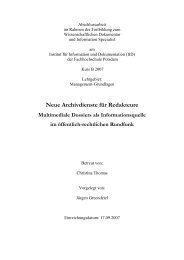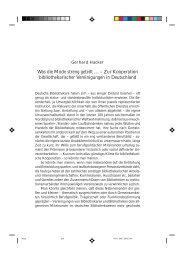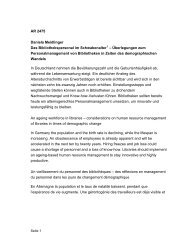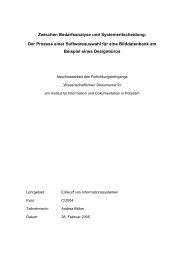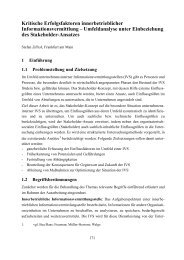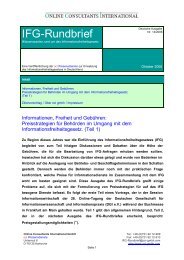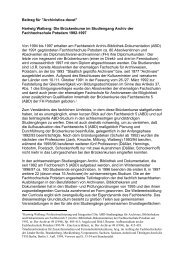PDF(886K) - Wiley Online Library
PDF(886K) - Wiley Online Library
PDF(886K) - Wiley Online Library
Create successful ePaper yourself
Turn your PDF publications into a flip-book with our unique Google optimized e-Paper software.
applications....In fact, given the Web’s fractual nature, those<br />
costs might decrease as an ontology’s user base increase. If<br />
we assume that ontology building costs are spread across<br />
user communities, the number of ontology engineers required<br />
increases as the log of the community’ size.<br />
This approach can only be used if, first, the knowledge<br />
domain is small and overseeable and, second, the members<br />
of the respective community of scientists are willing to contribute<br />
to the construction and maintenance of the ontology.<br />
Such an approach seems not to work at all beyond the borders<br />
of disciplines. The second approach, to consolidate<br />
the Semantic Web, proceeds via tagging and folksonomies<br />
(Shadbolt et al., 2006, p. 100):<br />
Tagging on a Web scale is certainly an interesting development.<br />
It provides a potential source of metadata. The<br />
folksonomies that emerge are a variant on keyword searches.<br />
They’re an interesting emergent attempt at information<br />
retrieval.<br />
Folksonomies, however, exclusively have syntagmatic<br />
relations. If one wants to render such an approach usable<br />
for the Semantic Web (now as the “Social Semantic Web;”<br />
Weller, 2010), focused work in “Tag Gardening” would seem<br />
to be required (Peters & Weller, 2008b). Equally open, in our<br />
view, is the question of indexing documents in the Semantic<br />
Web. Who will perform this work—the author, the users,<br />
or—as automatic indexing—a system?<br />
For Weller (2010), principally using only ontologies for<br />
the Semantic Web is an excessive approach. Ontologies are<br />
far too complicated for John Q. Web User in terms of structure<br />
and use. Weller’s suggestion boils down to a simplification of<br />
the concept system: Not all aspects of ontologies have to be<br />
realized, the desired effects might also be achieved by a less<br />
expressive method (e.g., a thesaurus). The easier the concept<br />
systems are to use for the individual, the greater the<br />
probability of many users participating in the collaborative<br />
construction of the Semantic Web will be.<br />
Semantic-rich KOSs, notably thesauri and ontologies,<br />
only work well in small knowledge domains. Therefore, we<br />
have to consider the problem of semantic interoperability<br />
between different KOS (Gödert 2010a,b), i.e., the formulation<br />
of relations of (quasi-)synonymy, hierarchy, etc. (as<br />
means of semantic crosswalks) between singular concepts<br />
and compounds beyond the borders of single KOS (Stock &<br />
Stock, 2008, p. 291) to form a “universal” KOS which is<br />
needed for the Semantic Web.<br />
The vision of a universal Semantic Web on the basis<br />
of ontologies is being set very narrow boundaries with the<br />
approaches introduced by Shadbolt et al. (2006). The ruins of<br />
a similar vision of summarizing world knowledge—Otlet’s<br />
and La Fontaine’s “Mundaneum” (Torres-Vargas, 2005)—<br />
can today be admired in a museum in Mons, Belgium. We do<br />
not propose that a Semantic Web is principally impossible;<br />
we merely wish to stress that research on concepts and relations<br />
is very useful on the way to the Semantic Web. Both the<br />
construction of all sorts of KOS as well as tag gardening are<br />
genuine domains of information science.<br />
Conclusion<br />
Let us summarize the important results of our theoretical<br />
journey through the jungle of concept theory, theory of<br />
semantic relations, and KOS.<br />
(1) It is a truism, but we want to mention it in the first place:<br />
Concept-based information retrieval is only possible if we<br />
are able to construct and to maintain adequate KOS.<br />
(2) Concepts are defined by their extension (objects) and<br />
by their intension (properties). It is possible to group<br />
similar objects (via classification) or unlike objects (via<br />
colligation) together, depending on the purpose of the<br />
KOS.<br />
(3) There are five epistemological theories on concepts in the<br />
background of information science: empiricism, rationalism,<br />
hermeneutics, critical theory, and pragmatism. None<br />
of them should be forgotten in activities concerning KOS.<br />
(4) Concepts are (a) categories, (b) general concepts, and<br />
(c) individual concepts. Categories and individual concepts<br />
are more or less easy to define, but general concepts<br />
tend to be problematic. Such concepts (such as chair)have<br />
fuzzy borders and should be defined by prototypes. Every<br />
concept in a KOS has to be defined exactly (by extension,<br />
intension, or both). In a concept entry, all properties<br />
(if applicable, objects as well) must be listed completely<br />
and in a formal way. It is not possible to work with<br />
the inheritance of properties if we do not define those<br />
properties.<br />
(5) In information science, we mainly work with two kinds<br />
of definition, namely, concept explanation and family<br />
resemblance. Concepts, which are defined via family<br />
resemblance (vegetable or game), do not pass all properties<br />
down to their narrower terms. This result is important<br />
for the design of ontologies.<br />
(6) Concepts can be presented as frames with sets of attributes<br />
and values, structural invariants (relations), and rulebound<br />
connections.<br />
(7) Concept systems are made up of concepts and semantic<br />
relations between them. Semantic relations are either syntagmatic<br />
relations (co-occurrences of terms in documents)<br />
or paradigmatic relations (tight relations in KOS). There<br />
are three kinds of paradigmatic relations: equivalence,<br />
hierarchy, and further specific relations.<br />
(8) Especially for hierarchic relations, transitivity plays an<br />
important role for query expansion. Without proven transitivity,<br />
it is not possible to expand a search argument with<br />
concepts from hierarchical levels with distances greater<br />
than one.<br />
(9) Equivalence has three manifestations: synonymy, genidentity,<br />
and antonymy. Absolute synonymy, which is<br />
very sparse, is a relation between a concept and different<br />
words. All other kinds of synonymy, often called<br />
“quasi-synonymy,” are relations between different concepts.<br />
Gen-identity describes an object in the course of<br />
time. Contradictory antonyms are useful in information<br />
retrieval, but only with constructions like “not” or “un-.”<br />
(10) Hierarchy is the most important relation in every KOS.<br />
It consists of the (logic-oriented) hyponym-hyperonymrelation<br />
(with two subspecies, simple hyponymy and<br />
taxonomy), the (object-oriented) meronym-holonymrelation<br />
(with a lot of subspecies), and the instance relation<br />
1966 JOURNAL OF THE AMERICAN SOCIETY FOR INFORMATION SCIENCE AND TECHNOLOGY—October 2010<br />
DOI: 10.1002/asi



